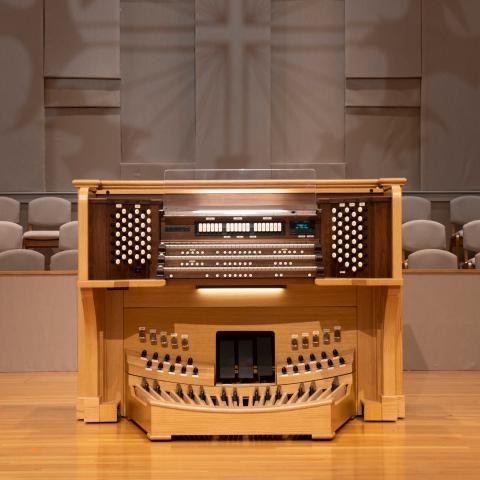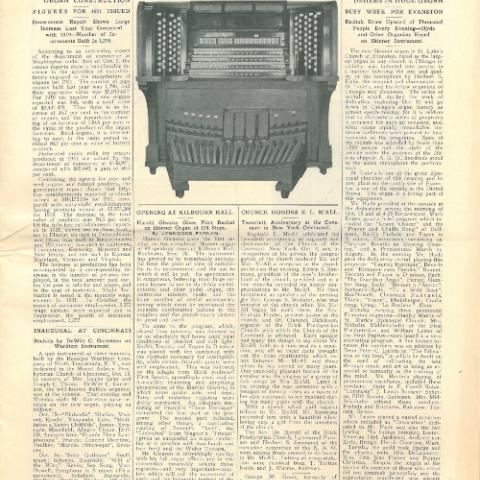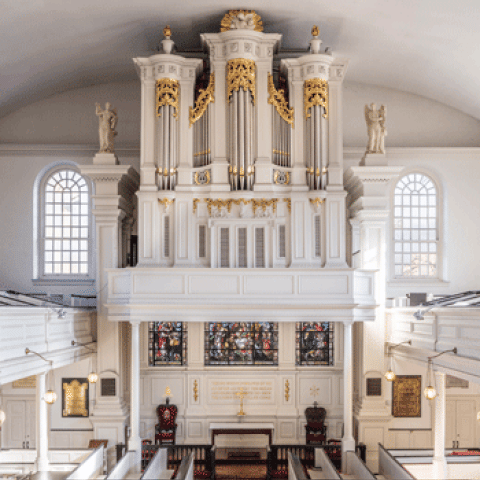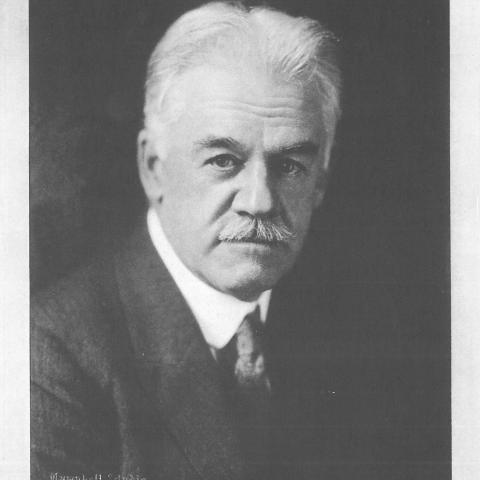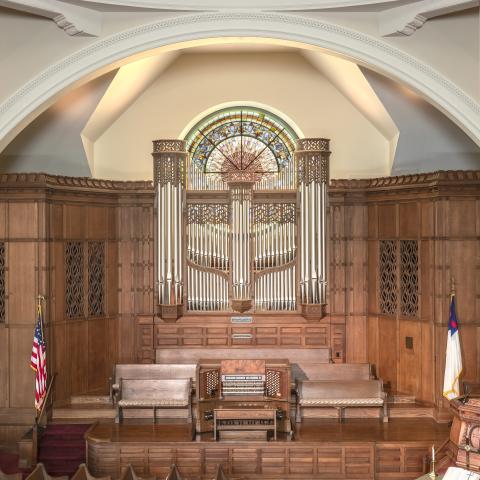A. Thompson-Allen Company, New Haven, Connecticut; Saint Peter’s Episcopal Church, Philadelphia, Pennsylvania

Philadelphia’s Society Hill
Society Hill is Center City Philadelphia’s oldest residential neighborhood, a one-quarter square-mile area that was first settled in the 1680s. It took its name from the Free Society of Traders, an association of merchants and landowners chosen by William Penn to shape the future of that growing city. During the nineteenth century, as Philadelphia’s population expanded westward away from the Delaware River, the area became rundown and disreputable, and by the end of the Second World War was one of that city’s worst slums. A successful urban renewal program begun in the 1950s largely returned Society Hill to its former character. Today it is known for its expanse of eighteenth- and early nineteenth-century row houses, traversed by narrow cobblestone streets lined with brick sidewalks and punctuated by street lamps after a design by Benjamin Franklin.
Saint Peter’s Church
Saint Peter’s Episcopal Church, at the corner of Third and Pine Streets, was originally intended as a “chapel of ease” for nearby Christ Church and was built to accommodate the burgeoning congregation of that parish. On land donated by two of William Penn’s sons, architect-builder Robert Smith (1722–1777) designed a church based upon Christopher Wren’s “auditory” style. With this plan, sightlines and speech clarity are of primary importance, especially for a worship service focused upon Scripture and preaching. The first services in the church were held on September 4, 1761.
It is an edifice of breathtaking elegance in its simplicity. To stand within its sun-drenched walls, absorbing the ambience of centuries, is to experience a whiff of eighteenth-century Philadelphia. Many civic luminaries have been members of Saint Peter’s. Mayor Samuel Powel, who lived just down Third Street, often shared his family’s pew with George and Martha Washington.
Saint Peter’s is one of two churches of its type surviving in America, the other located in Cooper River, South Carolina, built in 1763. In these churches, the pulpit and lectern are at the opposite end of the main aisle from the altar, which is placed against the east wall, beneath a large Palladian window. Most of the tall box pews have seating on three sides. Following the readings and sermon, the congregation turns and faces the altar for the rest of the service.
In 1832 Saint Peter’s and Christ Church parted ways and became separate parishes. Ten years later, the vestry commissioned William Strickland to build a new tower to accommodate a chime of eight bells given by Benjamin Chew Wilcocks. The soaring 210-foot tower and steeple are conspicuously out of scale with Robert Smith’s church, perhaps to allow the bells to be heard at a greater distance, or possibly to reflect the congregation’s desire to establish a strong visual presence in its neighborhood.
Earlier instruments
The first permanent organ for Saint Peter’s was constructed by Philip Feyring (1730–1767), who died the year it was completed. His two-manual instrument consumed almost half of the north gallery and caused regular complaints from those seated nearby that it was too loud. In 1774 the vestry voted to remove the organ and put it into storage until it could be sold. Fortunately, nothing happened for fifteen years, and then in 1789 Feyring’s organ was moved to a newly constructed organ loft above the altar, where it continues to cover most of the Palladian window behind it.
This instrument served Saint Peter’s for more than fifty years and in 1815 was either rebuilt or replaced (vestry records are sometimes incomplete). Little is known about this second instrument apart from its short career in the church. In 1829 London-trained organ-builder Henry Corrie furnished a new instrument using some of the pipes from the 1815 organ. Corrie’s work served for twenty-seven years, but in 1855 local builder John C. B. Standbridge reported that it was beyond repair. The following year he signed a contract for a new instrument, dedicated in 1857.
Hilborne Roosevelt rebuilt the Standbridge organ in 1886 and added a third manual to the console. Within two years, however, the vestry began to consider replacing the “double quartet” that stood with the organ in the loft, with a men-and-boys choir on the main floor of the church. Charles S. Haskell, a former employee of the Roosevelt firm, electrified the organ in 1892 and provided a four-manual console placed among the new choir stalls on the main floor. Additions in 1911 included a small Echo Organ, located within the walls of the original tower immediately behind the pulpit door, and a Choir Organ, placed unfortunately beneath an iron grate under the choir stalls in a basement chamber.
The Choir Organ suffered from constant dampness and regular water seepage, especially following a heavy rainfall. Eight years after the Choir Organ was installed, Haskell had to remove portions of that division for repairs. A contract dispute between Haskell and the vestry ensued in 1921, with the builder refusing to return the parts taken from the church. About 1928 the Choir Organ was completely removed, and its chamber abandoned.
The Skinner organ
Weary of their troublesome instrument, parts of which were very old, the vestry contracted with the Skinner Organ Company to build an entirely new instrument, their Opus 862, finished in November 1931. It is a three-manual, 49-stop organ placed entirely within the organ case, which was enlarged (probably in the 1892 rebuilding) by bringing the façade forward to the edge of the organ loft. Nothing except Feyring’s case remains of the earlier instruments, and there is credible speculation that even it was made by David Tannenberg of nearby Lititz, Pennsylvania.
As the Skinner organ approached fifty years old, its pneumatic leatherwork began to fail. Saint Peter’s vestry was committed to keeping the organ in good order, and much of the instrument was releathered as necessary to keep the organ playing reliably. At ninety-one years, the Skinner organ holds the record for the longest tenure of all of Saint Peter’s instruments. The current work is the first comprehensive restoration of this organ.
—Joseph F. Dzeda
The restoration of Opus 862
The mechanism and pipework were found to be mostly complete. The original “vertical selector” electro-pneumatic console was long gone and had been replaced, first by an Austin tab console in the 1970s, and then by a solid-state console by David Harris in 1985. Richard Houghten updated and rebuilt this console in 2017, and it remains as such. All of the components of the 1931 chassis remain and have been fully restored.
Opus 862 underwent tonal changes characteristic of their time. The 4′ Flute on the Great was replaced by a high-pitched mixture, and the Great 8′ Tromba, enclosed in the Choir expression box, was revoiced as a bright Trumpet. The Choir Nazard was replaced by a 4′ Principal. The Class A Deagan Cathedral Chimes were removed, along with their electric action, from the Swell box, and the Harp/Celesta was removed from the Choir box in preparation for tonal additions that were never realized.
The pipework was mostly complete and has been restored to the original specifications except for one missing stop, the Swell Aeoline. This stop was a 75-scale string, also sometimes called Echo Gamba or Dulcet. These are very rare. We did replace it with a 75-scale Dulcet from an earlier Skinner. Also missing were the Harp and Chimes. These have been replaced with identical items from Opus 659.
The blower has been fully restored by Joseph Sloane, converting the original motor from two-phase to three-phase. The reeds have been restored by Chris Broome of Broome & Co., LLC, to the original specifications. The original reed tongues were gone and had been replaced with thinner tongues and reduced loading. Chris Broome has replaced these using the thickness and loading schedules as listed in the Skinner records. The goal of the restoration has been to restore the organ to “as built” condition throughout.
From the Skinner documents we have acquired, it is clear that Opus 862 was overseen and designed by Ernest Skinner personally. For point of reference, we are going to compare Opus 862 with Opus 836, Saint Peter’s Episcopal Church in Morristown, New Jersey. We are including the original voicer’s charts for both organs. Opus 836, again from factory documents, was clearly overseen by G. Donald Harrison. The two organs are similar in many ways. The strings and flutes are identical for the most part, but the chorus reeds and principal choruses are quite different. As indicated in the reed voicer’s charts, the Swell chorus reeds are “Skinner” in 862, and the Swell chorus reeds are “English” in 836. The “Skinner” reeds are harmonic at 2′ F-sharp and the “English” reeds are harmonic at 1′ F#, and the harmonic pipes are spotted metal. The “Skinner” reeds have different shallots and loading producing a rounder, fuller, and refined tone. The “English” reeds are brighter with more “clang” and are reproductions of Willis reeds. The specifications of the “English” reeds were part of the exchange established between Skinner and Henry Willis III during their quid pro quo arrangement of exchanging Skinner’s mechanical innovations with Willis’s pipe construction and reed voicing details. Both of these reed choruses are beautiful in their own way, but the differences are very obvious.
The same can be said for the principal choruses. If you compare the two flue voicer’s charts, you will notice that there are no 1/4 mouths in 862. The upper work is more restrained in 862, and conversely more pronounced in 836. The biggest and most noticeable difference is that if you run up the scale on any of the Diapason stops, 862 gently fades, while 836 is pushed to the limit. I believe that this is due to the Willis influence as carried out by Harrison. It is interesting to note that Harrison abandoned both of these tonal set ups after 1932. These are both beautiful Skinner organs from the same period but realized differently by Skinner and Harrison.
—Nicholas Thompson-Allen
Frederick Lee Richards’s 1992 paper, Old St. Peter’s Protestant Episcopal Church, Philadelphia: An Architectural History and Inventory (1758-1991), provided much of the historical information cited above.
Builder’s website: www.thompson-allen.com
Church’s website: www.stpetersphila.org
Photo credit: David Ottenstein Photography (©2022 David Ottenstein)
GREAT (5″ wind pressure)
16′ Bourdon (Pedal) 17 pipes
8′ First Diapason 61 pipes
8′ Second Diapason 61 pipes
8′ Principal Flute 61 pipes
8′ Erzähler 61 pipes
4′ Principal 61 pipes
4′ Flute 61 pipes
II Grave Mixture (2-2⁄3′ – 2′) 122 pipes
Enclosed in Choir box 10″ w.p.
8′ Tromba 61 pipes
8′ French Horn 61 pipes
Chimes (in Swell box) 20 tubes
SWELL (Enclosed) (71⁄2″ wind pressure)
16′ Echo Lieblich 73 pipes
8′ Diapason 73 pipes
8′ Rohrflöte 73 pipes
8′ Salicional 73 pipes
8′ Voix Celeste (CC) 73 pipes
8′ Aeoline 73 pipes
4′ Octave 73 pipes
4′ Flute Triangulaire 73 pipes
2′ Flautino 61 pipes
III Mixture (C-14) 183 pipes
16′ Waldhorn 73 pipes
8′ Cornopean 73 pipes
8′ Oboe 73 pipes
8′ Vox Humana 73 pipes
Tremolo
CHOIR (Enclosed) (6″ wind pressure)
16′ Contra Gamba 61 pipes
8′ Diapason 61 pipes
8′ Concert Flute 61 pipes
8′ Gamba 61 pipes
8′ Dulciana 61 pipes
8′ Unda Maris (TC) 49 pipes
4′ Flute 61 pipes
2-2⁄3′ Nazard 61 pipes
8′ Clarinet 61 pipes
8′ English Horn 61 pipes
Harp (TC) 49 bars
Celesta (CC) 12 bars
Tremolo
PEDAL (6″ wind pressure)
32′ Resultant
16′ Diapason (bearded) 32 pipes
16′ Bourdon 32 pipes
16′ Echo Lieblich (Swell)
16′ Contra Gamba (Choir)
8′ Octave (ext Diapason) 12 pipes
8′ Gedeckt (ext Bourdon) 12 pipes
8′ Still Gedeckt (Swell)
8′ Cello (Choir)
32′ Fagotto 12 pipes (10″ w.p., ext Sw Waldhorn)
16′ Trombone 12 pipes (10″ w.p., ext Gt Tromba)
16′ Waldhorn (Swell)
Chimes
49 stops, 38 ranks, 2,457 pipes

